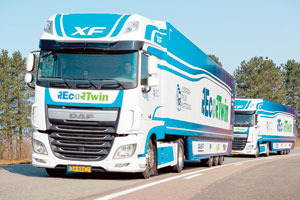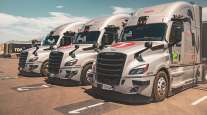Managing Editor, Features and Multimedia
Truck Platooning Could Reach Market in 2017

This story appears in the July 11 print edition of iTECH, a supplement to Transport Topics.
Interest in truck platooning continues to grow as manufacturers and suppliers showcase the technology and one company prepares for a commercial launch of its product.
Platooning systems electronically connect two or more trucks to synchronize their braking, thus enabling the vehicles to form tight convoys with shorter following distances that improve fuel economy.
Peloton Technology said it is nearing completion on its platooning system and aims for a full launch in 2017 after integration work with braking suppliers.
“Through the rest of this year we will run a few fleet trials, putting the pre-production system in use in a handful of trucks in a daily fleet operation,” said Josh Switkes, co-founder and CEO of the Mountain View, California-based company.
On the other side of the Atlantic, six truck manufacturers recently participated in a large-scale platooning demonstration in Europe aimed at bringing the technology one step closer to implementation.
CHAT WITH SETH: TT Technology Editor Seth Clevenger takes your questions, noon EDT, July 18
BEST OF JULY iTECH: More stories, columns
During the European Truck Platooning Challenge, heavy trucks traveled in platoons on public roads in Sweden, Denmark, Germany and Belgium before arriving at Rotterdam in the Netherlands on April 6.
The event, which featured automated trucks from Daimler, Volvo, Scania, Daf, Iveco and MAN, was initiated by the Dutch government during the country’s presidency of the European Union.
“We started the challenge itself because we wanted to show it really is going to happen,” said Dirk-Jan de Bruijn, program director for the platooning challenge. “It’s not a study. It’s not research. It’s learning by doing. That was the idea.”
Much like North America, Europe faces a serious infrastructure challenge in the years ahead as traffic levels increase, and new technologies could be part of the solution.
“We have reached the limits of our infrastructure,” de Bruijn said. “We need to invest in smart mobility so we can use our infrastructure in another way.”
Platooning is relatively simple to implement and realize, he said, making it a “low-hanging fruit” within the broader spectrum of emerging vehicle-automation technologies.
However, he also acknowledged that “there is still a lot of work to do” to harmonize the different rules and laws that come into play as trucks cross international borders throughout Europe. For the platooning challenge, the organizers worked with exemption procedures.
Platooning technology may evolve over time, but Peloton’s Switkes said it could help fleets achieve fuel savings and safety benefits today.
The company said its system can cut fuel consumption by 10% for the following truck and 4.5% for the lead truck.
“We set the following distance based on what we are sure is safe, based on the braking capabilities of the two trucks,” Switkes said. Which form of truck automation would you most readily embrace?
Peloton’s initial product will be limited to two trucks and will automatically control acceleration and deceleration but not steering.
In other words, drivers will take their feet off the pedal but will keep their hands on the wheel and their eyes on the road, Switkes said.
However, future updates to the product could expand the size of the platoon and add steering automation to the system, he said.
“Once we have validated three-truck and longer platoons, and once the public and regulators are comfortable with these longer platoons, we will roll out an over-the-air update to enable these, which come with larger fuel savings,” Switkes said.
Peloton also plans to add automated steering to its system in the future, he added, but will do so only when that technology is ready and “part of a fully validated safe system.”
Peloton intends to offer platooning on a variety of truck makes equipped with a wide range of braking and powertrain systems.
The company also aims to make the system a retrofit option on some trucks, specifically those with adaptive cruise control and collision mitigation technology.
Jonny Morris, Peloton’s external affairs and public policy lead, said the United States is “probably the best country in the world for truck platooning.”
“Other countries are very spread out but don’t have a huge amount of freight volume, or they’re much more dense. The U.S. in a lot of ways is in that sweet spot,” he said.
Truckload carrier NFI Industries would be interested in platooning for its fuel-economy advantages, “once the technology has further evolved,” said Bill Bliem, senior vice president of fleet services.
“It is rare that two trucks in our fleet are going to the same location at the same time,” he said. “Therefore, this technology would only be really valuable through cross-fleet participation, allowing different companies to collaborate for mutual cost-saving efforts.”




